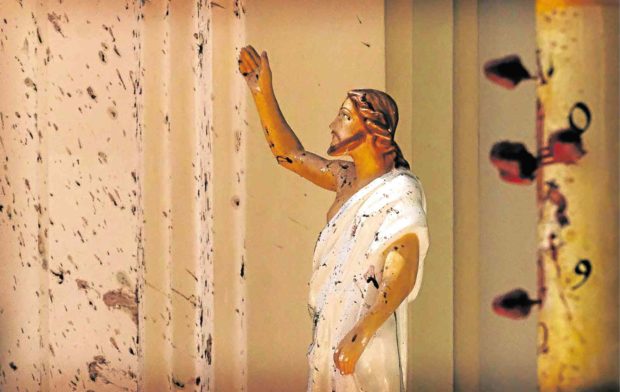
BLOODIED The wall and the statue of Jesus Christ at St. Sebastian’s Church are stained with blood after the bomb explosion on Easter Sunday in Negombo, north of the Sri Lankan capital of Colombo. —AP
COLOMBO, Sri Lanka — The coordinated Easter Sunday bombings that ripped through Sri Lankan churches and luxury hotels were carried out by seven suicide bombers, a government investigator said on Monday.
An analysis of the attackers’ body parts made clear that they were suicide bombers, said Ariyananda Welianga, a forensic crime investigator.
He said most attacks were by one bomber, with two at Colombo’s Shangri-La Hotel.
The bombings, Sri Lanka’s deadliest violence since a devastating civil war ended a decade ago on the island nation, killed at least 290 people with more than 500 wounded, police spokesperson Ruwan Gunasekara said on Monday.
Intelligence failure
Police investigating the bombings are examining reports that intelligence agencies had warnings of possible attacks, officials said.
Two government ministers have alluded to intelligence failures.
Telecommunications Minister Harin Fernando tweeted, “Some intelligence officers were aware of this incidence. Therefore, there was a delay in action. Serious action needs to be taken as to why this warning was ignored.”
He said his father had heard of the possibility of an attack as well and had warned him not to enter popular churches.
And Mano Ganeshan, the minister for national integration, said his ministry’s security officers had been warned by their division about the possibility that two suicide bombers would target politicians.
The police’s Criminal Investigation Department, which is handling the investigation into the blasts, will look into those reports, Gunasekara said.
Religious extremists
Earlier, Defense Minister Ruwan Wijewardena described the blasts as a terrorist attack by religious extremists, and police said 13 suspects had been arrested, though there was no immediate claim of responsibility.
Wijewardena said most of the bombings were believed to have been suicide attacks.
But officials have yet to say who they believe is behind the attacks.
The Tamil Tigers, once a powerful rebel army known for its use of suicide bombers, was crushed by the government in 2009, and had little history of targeting Christians.
While anti-Muslim bigotry has swept the island in recent years, fed by Buddhist nationalists, the island also has no history of violent Muslim militants.
The country’s small Christian community has seen only scattered incidents of harassment in recent years.
Mostly in Colombo
The explosions—mostly in or around Colombo, the capital—collapsed ceilings and blew out windows, killing worshippers and hotel guests in one scene after another of smoke, soot, blood, broken glass, screams and wailing alarms.
A morgue worker in the town of Negombo, outside Colombo, where St. Sebastian’s Church was targeted, said many bodies were hard to identify because of the extent of the injuries. He spoke on condition of anonymity.
At Shangri-La Hotel, a witness said “people were being dragged out” after the blast.
“There was blood everywhere,” said Bhanuka Harischandra, a 24-year-old from Colombo and founder of a tech marketing company.
He was heading to the hotel for a meeting when it was bombed.
“People didn’t know what was going on. It was panic mode,” he said.
27 foreigners killed
Most of those killed were Sri Lankans. But the three bombed hotels and one of the churches, St. Anthony’s Shrine, are frequented by foreign tourists, and Sri Lanka’s foreign ministry said the bodies of at least 27 foreigners from a variety of countries were recovered.
The United States said “several” Americans were among the dead, while Britain, India, China, Japan and Portugal said they, too, lost citizens.
The streets were largely deserted on Monday morning, with most shops closed and a heavy deployment of soldiers and police.
Stunned clergy and onlookers gathered at St. Anthony’s Shrine, looking past the soldiers to the stricken church.
The Sri Lankan government lifted a curfew that had been imposed during the night.
But most social media remained blocked on Monday after officials said they needed to curtail the spread of false information and ease tension in the country of about 21 million people.
Prime Minister Ranil Wickremesinghe said he feared the massacre could trigger instability in Sri Lanka, and he vowed to “vest all necessary powers with the defense forces” to take action against those responsible.
Merciless punishment
The archbishop of Colombo, Cardinal Malcolm Ranjith, called on Sri Lanka’s government to “mercilessly” punish those responsible “because only animals can behave like that.”
The scale of the bloodshed recalled the worst days of Sri Lanka’s 26-year civil war, when the Tamil Tigers, from the ethnic Tamil minority, sought independence from the Sinhalese-dominated country.
The Sinhalese are largely Buddhist. The Tamils are Hindu, Muslim and Christian.
Sri Lanka, off the southern tip of India, is about 70 percent Buddhist. In recent years, tensions have been running high between hardline Buddhist monks and Muslims.
Two Muslim groups in Sri Lanka condemned the church attacks, as did countries around the world, and Pope Francis expressed condolences at the end of his traditional Easter Sunday blessing in Rome.
Six nearly simultaneous blasts took place in the morning at the shrine and the Cinnamon Grand, Shangri-La and Kingsbury hotels in Colombo, as well as at two churches outside Colombo.
A few hours later, two more blasts occurred just outside Colombo, one at a guesthouse where two people were killed, the other near an overpass.
Also, three police officers were killed during a search at a suspected safe house on the outskirts of Colombo when its occupants apparently detonated explosives to prevent arrest, authorities said.